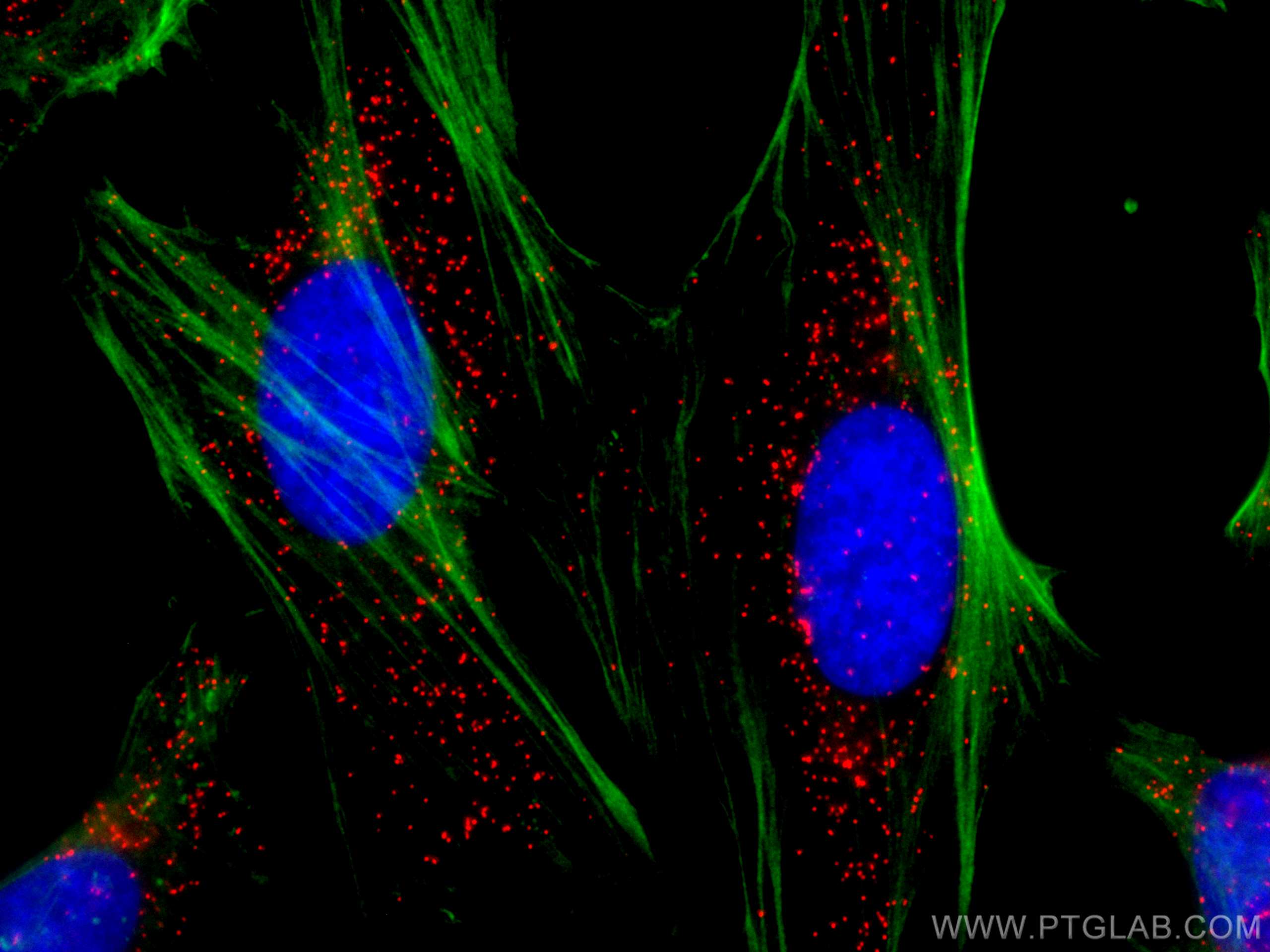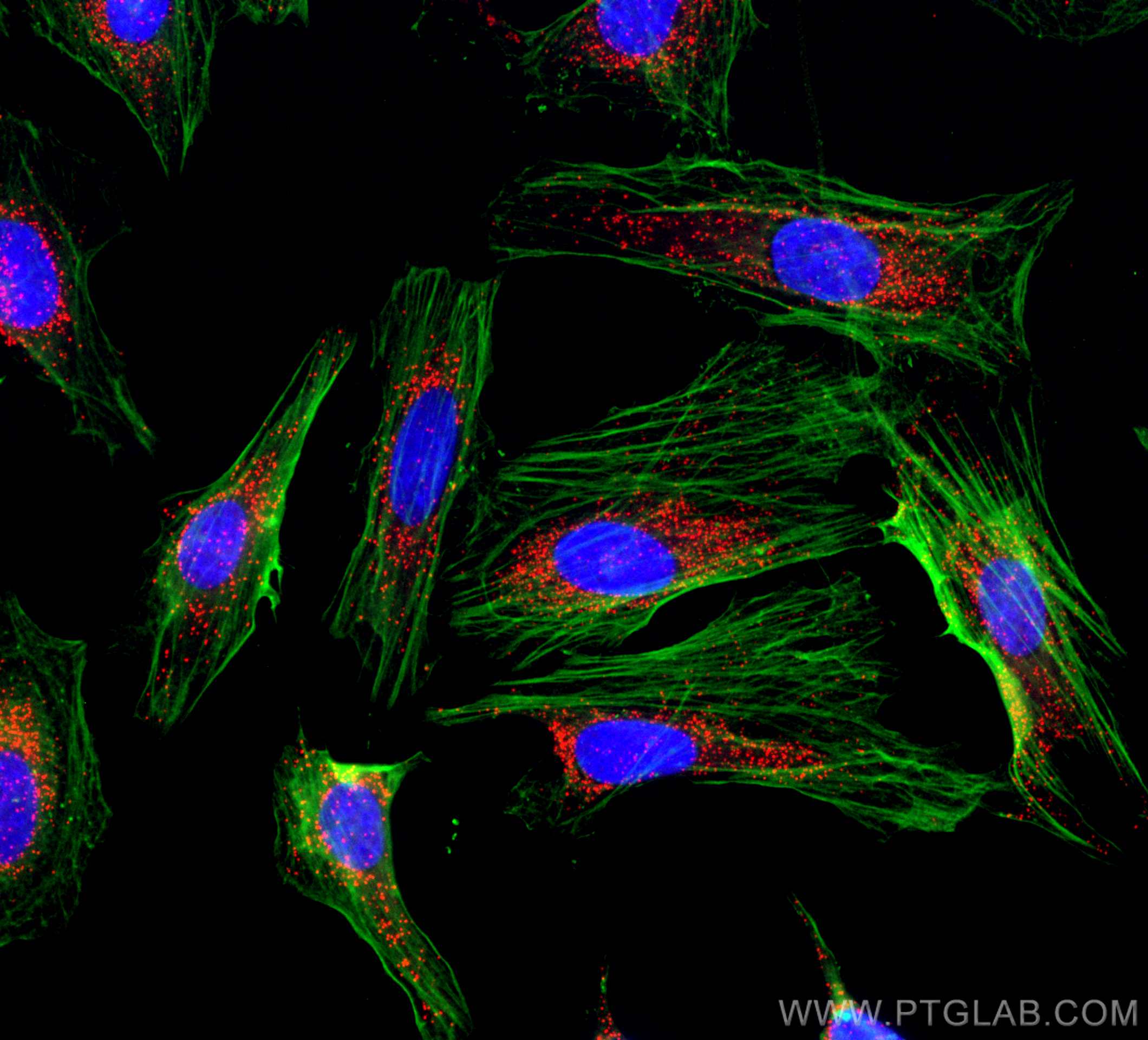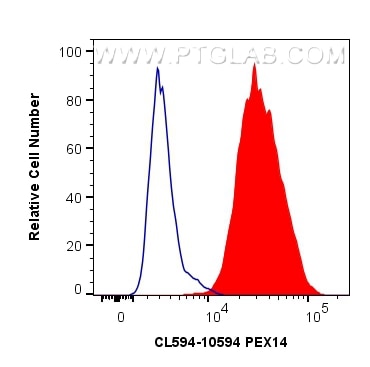PEX14 Polyklonaler Antikörper
PEX14 Polyklonal Antikörper für FC (Intra), IF
Wirt / Isotyp
Kaninchen / IgG
Getestete Reaktivität
human, Maus, Ratte
Anwendung
IF, FC (Intra)
Konjugation
CoraLite®594 Fluorescent Dye
Kat-Nr. : CL594-10594
Synonyme
Galerie der Validierungsdaten
Geprüfte Anwendungen
| Erfolgreiche Detektion in IF | HeLa-Zellen |
| Erfolgreiche Detektion in FC | HeLa-Zellen |
Empfohlene Verdünnung
| Anwendung | Verdünnung |
|---|---|
| Immunfluoreszenz (IF) | IF : 1:200-1:800 |
| Durchflusszytometrie (FC) | FC : 0.80 ug per 10^6 cells in a 100 µl suspension |
| It is recommended that this reagent should be titrated in each testing system to obtain optimal results. | |
| Sample-dependent, check data in validation data gallery | |
Veröffentlichte Anwendungen
| IF | See 6 publications below |
Produktinformation
CL594-10594 bindet in IF, FC (Intra) PEX14 und zeigt Reaktivität mit human, Maus, Ratten
| Getestete Reaktivität | human, Maus, Ratte |
| In Publikationen genannte Reaktivität | human, Maus, Ratte |
| Wirt / Isotyp | Kaninchen / IgG |
| Klonalität | Polyklonal |
| Typ | Antikörper |
| Immunogen | PEX14 fusion protein Ag0932 |
| Vollständiger Name | peroxisomal biogenesis factor 14 |
| Berechnetes Molekulargewicht | 41 kDa |
| Beobachtetes Molekulargewicht | 57 kDa |
| GenBank-Zugangsnummer | BC006327 |
| Gene symbol | PEX14 |
| Gene ID (NCBI) | 5195 |
| Konjugation | CoraLite®594 Fluorescent Dye |
| Excitation/Emission maxima wavelengths | 588 nm / 604 nm |
| Form | Liquid |
| Reinigungsmethode | Antigen-Affinitätsreinigung |
| Lagerungspuffer | BS mit 50% Glyzerin, 0,05% Proclin300, 0,5% BSA, pH 7,3. |
| Lagerungsbedingungen | Bei -20°C lagern. Vor Licht schützen. Nach dem Versand ein Jahr stabil. Aliquotieren ist bei -20oC Lagerung nicht notwendig. 20ul Größen enthalten 0,1% BSA. |
Hintergrundinformationen
PEX14 (peroxisomal biogenesis factor 14) is a peroxisomal membrane protein that is essential for protein docking onto the peroxisomes. It is a central component of the peroxisimal matrix protein import machinery and interacts with PEX5 and PEX19. PEX14 is ubiquitously expressed and defects in PEX14 are the cause of peroxisome biogenesis disorder complementation group K (PBD-CGK). This antibody can be used to detect endogenous PEX14 with an apparent molecular weight of 57 kDa (PMID: 16449325; 9653144) and recognize peroxisomal structures in human, monkey and mouse cells.
Protokolle
| Produktspezifische Protokolle | |
|---|---|
| IF protocol for CL594 PEX14 antibody CL594-10594 | Protokoll herunterladen |
| FC protocol for CL594 PEX14 antibody CL594-10594 | Protokoll herunterladen |
| Standard-Protokolle | |
|---|---|
| Klicken Sie hier, um unsere Standardprotokolle anzuzeigen |
Publikationen
| Species | Application | Title |
|---|---|---|
Mol Neurobiol Schwann Cell-Derived Exosomes Ameliorate Paclitaxel-Induced Peripheral Neuropathy Through the miR-21-Mediated PTEN Signaling Pathway | ||
Inflamm Res GCH1 reduces LPS-induced alveolar macrophage polarization and inflammation by inhibition of ferroptosis | ||
J Neuroinflammation TRIM45 aggravates microglia pyroptosis via Atg5/NLRP3 axis in septic encephalopathy | ||
Am J Physiol Cell Physiol OTUD6A in tubular epithelial cells mediates Angiotensin II-induced kidney injury by targeting STAT3 | ||
Pharmaceuticals (Basel) A Class I HDAC Inhibitor BG45 Alleviates Cognitive Impairment through the CaMKII/ITPKA/Ca2+ Signaling Pathway | ||
J Ethnopharmacol TMT quantitative proteomics and network pharmacology reveal the mechanism by which asiaticoside regulates the JAK2/STAT3 signaling pathway to inhibit peritoneal fibrosis |





